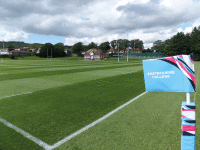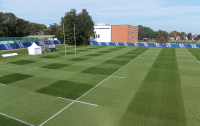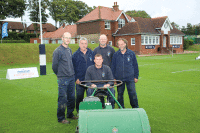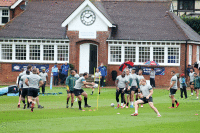Eastbourne College - Boxing for the Boks...

Eastbourne College was established in mid-Victorian times and is, these days, very much a front line co-educational independent school. I go there just a day or so into the new term - to its Memorial Ground facilities to be precise - and it is quiet, very quiet. I'm greeted by Richard Maryan, Head Groundsman at the south coast public school since 2006, and am taken into a particularly spick and span pavilion so we can chat in peace; which seems a little odd in such a tranquil setting on a late summer morning.
Another Neville, Neville Tweed, Richard's deputy, puts a stop to this by starting up a Ransomes Mastiff yards away, beginning what Richard explains has become a near daily routine in recent weeks on the rugby pitch in front of us. It's usually a well looked after under-16 pitch but, right now, it looks like Twickenham. There's a pretty good reason for this.

Pool B matches were to kick-off at nearby Brighton and Hove Albion's Amex Community Stadium, so it was in the running for either Samoa, the USA, Japan, or South Africa, who would all play there over the tournament's opening weekend. After visits from Rugby World Cup representatives and the Springboks, who as one of the seeded nations had first choice of training venues, Richard was told his pitch was going to be put to the test by one of the Webb Ellis Trophy favourites. The Boks were coming to Eastbourne. The College would be their official outdoor training team base.
The Rugby World Cup organisation makes a contribution to the renovation and maintenance of the pitches used by countries competing, but there is no fee as such. The benefit to the venues selected is simply one of prestige. Rugby is very much a big thing at Eastbourne College, so its World Cup involvement was always seen as something highly prized.

The College has announced too that, as a legacy for being chosen as a Rugby World Cup training venue, it plans to mark it in a special way and very much in keeping with its prowess as a rugby school. It says it intends to set up a bursary fund "to provide a life-changing opportunity for future generations of exceptional players who would otherwise not have the opportunity of an Eastbourne College education".
It was the Memorial Ground where I sat chatting to Richard that was to be where the Springboks would put the finishing touches to their pre-tournament training. It is used principally for under-16 cricket and rugby. It is the perfect level playing field, dating back to the late 1940s, when it was bought for Eastbourne College by a group of Old Eastbournians in memory of old boys who fell in both the World Wars. Like most of the school's sports facilities, it is set away from the main school and, as Richard explains, he and his team spend a lot of their time travelling between them.

"The school is very much rugby in the winter and cricket in summer. Only the First XV and First XI pitches are in the main school grounds, and plenty of hard work each year goes into making the same sports field fit for both. We are very proud of our College Field, but, just now, it's the Memorial Ground that's a priority."
In recent weeks, Richard and his team have, for once, switched the focus of their attention to the Springbok's training pitch. Richard says it would be pretty good every September, but not this good, he conceded.
Since the pitch had been chosen by the Springboks, there had been three pitch inspections there, the first about twelve months ago, by a company contracted to Rugby World Cup called Labosport, which conducted soil sampling, moisture levels and a number of other tests. The first results showed that thatch levels were on the high side, so scarification was stepped up and boxing of cuttings introduced for the first time this summer.
"Normally, all the mowing here would be done by gang mower, but time spent boxing-off does undoubtedly make a difference, and it definitely looks better. We wouldn't usually have the time, but this year we've had to make time."

No school sport at the Memorial Ground for the opening two or three weeks of term had put pressure on other facilities, and seeing the perfection of the rugby surface there perhaps meant there was a smidgen of envy from the First XV. This would surely be erased by the sheer excitement of the international visitors presence.
"Everyone at the school is very excited about the Springboks coming here," said Richard. "It's had quite an impact on College life."
Realisation of just what was ahead came right at the beginning of September, before the Springboks were due to arrive, when the Webb Ellis Trophy came to Eastbourne College. It's what all the fuss is about; Rugby's greatest prize. It was there as part of the Rugby World Cup Trophy Tour launched back in June, one hundred days before the opening match, and travelling through all the home nations before arriving at Twickenham Stadium for the Opening Ceremony.

The Memorial Ground Under-16 pitch had to be increased in size for Springboks' use, now stretching 95 metres, goal line to goal line, with a 6-metre in-goal area. Richard said that they did indeed do much more scarification to it than usual too.
Easter holiday renovation work this year included overseeding with a mix of Bar7 and Bar7 RPR, plus the addition of sixty tonnes of sand, brushed in after verti-draining.
Being on Downland chalk, the soil at the Memorial Ground is very shallow, only about 150mm generally. Drainage is therefore pretty good and ponding never an issue. Until the second half of August, rainfall had been noticeably down and irrigation got to be a worry for Richard. The tedious use of a travelling sprinkler became a must and another time consumer as the Springboks' visit drew closer.
Plantains had been especially stubborn this summer, so Richard had to resort to hand spot weeding to get on top of them. This was in addition to herbicide spraying.
He laughed: "At times, there were four of us walking up and down the pitch spot weeding, but it did the trick. Now there isn't a single plantain."

Richard tells me he used two controlled release fertilisers this year on the Memorial Ground pitch - Everris Sierrablen 28:5:5 in the spring and, later in the summer, Impact. Just ahead of the Springboks' training week, he would be applying a liquid feed for green-up, supplied to him by the Rugby World Cup. Looking at the pitch ten days before they arrived, it could hardly be greener, surely. The groundwork had been well and truly done, and very successfully.
Neville passed in front of us again. The Mastiff growled as it went about its business, the untouched pitch looking trimmer by the minute, getting its latest 30mm cut.
"This is new territory for us," said Richard. "We've never boxed off rugby pitches before. Neville and I are spending most of our time here right now. We've got this machine and another 30-inch Mastiff, plus a couple of old Dennis 36-inch pedestrians. They're doing a magnificent job for us. Between us, it takes about three hours to cut the whole of the Memorial Ground."
Richard had, earlier in the year, attended a workshop for all head groundsmen involved in the 2015 Rugby World Cup at Cobham Rugby Club in Surrey. It was one of four held up and down the country. Twickenham's Keith Kent had presided.
"It was extremely useful and I learned a lot from Keith about preparing a rugby pitch fit for top internationals," said Richard. "It got us all in World Cup spirit too."

The Memorial Ground went through the summer term's cricket as usual but, once the summer holidays began, preparations for the Springboks' week of training began in earnest. No more gang mowing. Boxing took over. Height of cut was higher than usual to allow the sward to thicken to the desired height.
For a week in September, the whole of the Memorial Ground would be shut off completely from the outside world, surrounded by privacy hoarding. Such is the importance of the Rugby World Cup.
Richard is actually quite a rugby follower and has a son making headway in the game at Eastbourne RFC. He was looking forward to getting a privileged, close-up look at the Springboks being put through their paces on his pitch. He wouldn't be sorry to get back to the normal routines though and getting the Under-16s back on their pitch.
Just then, the Jimi Hendrix guitar intro to Voodoo Chile interjects. It's Richard's mobile ringtone. After a conversation he has with the school's Director of Sport, Mike Harrison he tells me he's quite a rock fan and admits that the mega mowing sessions have given him the opportunity for some quiet listening to favourite tracks. AC/DC whilst crossing the 25 on a Mastiff? You'd never know.
